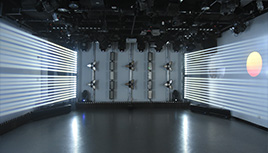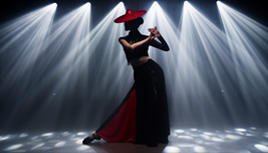Customization and Special Effects in Stage Lighting
2025-02-12 Post By: Longmangroup
In the stage lighting industry, the demand for customization and special effects has been growing as performances become more sophisticated and visually complex. From gobo projections and dynamic color changes to intricate patterns and textures, these effects are often central to creating a unique and immersive atmosphere for the audience. However, the challenges surrounding the customization of stage lighting—both in hardware and software—pose significant difficulties for designers, technicians, and manufacturers alike. These challenges include the complexity of design, high costs, time constraints, and the need for specialized skills to execute such effects effectively.Challenges in Customization and Special Effects:
1. Complexity of Design and Integration
Creating custom lighting effects, such as gobo projections or specific pattern effects, requires careful planning and design. Each effect is often unique to the performance, requiring that the lighting system be tailored to achieve a specific result. The complexity increases when integrating these effects into existing systems, particularly if the fixtures are not built to support such customizations or if they need to work in conjunction with other technologies, such as automated rigging, sound systems, or video projections.
Example: For a theater production that involves a scene set in a forest, a lighting designer might want to project custom gobo patterns of trees and leaves on the stage floor and background. Achieving this effect requires specialized gobo wheels and a fixture capable of rotating and adjusting the focus and sharpness of the projection to match the artistic vision.
Solution: The solution lies in using versatile lighting fixtures that offer a high degree of flexibility. Fixtures like the Claypaky Sharpy or Robe Spiider offer modular gobo wheels and interchangeable lenses, allowing designers to customize patterns and effects. In addition, some LED fixtures, such as the ETC Source Four LED, allow for precise gobo projection with the ability to swap out custom patterns. Furthermore, manufacturers now offer software packages that help lighting designers integrate these custom effects seamlessly into a show’s overall lighting control system.
2. Cost and Time Constraints
Customization often comes with significant costs, both in terms of time and money. Creating unique lighting effects usually involves custom gobo design, the creation of special filters, or even the development of bespoke software for controlling these effects. These processes can be time-consuming, especially for large-scale productions with multiple scenes requiring different lighting effects. The budget constraints for smaller productions also add to the challenge, as custom fixtures and effects can be prohibitively expensive.
Example: A corporate event may require a custom logo projection as part of the event’s branding, but the creation of a custom gobo design and projection system can be an expensive addition to the overall budget. Additionally, the time spent creating and testing these effects can delay the overall setup process.
Solution: Manufacturers have responded by designing more cost-effective solutions that offer a range of customizable features within affordable price points. For instance, LED-based moving heads like the Chauvet Professional Maverick series feature high-quality, interchangeable gobos and color mixing options, making them suitable for a variety of effects without the need for expensive custom designs. Furthermore, many manufacturers offer software updates and pre-programmed effect libraries, enabling designers to implement complex effects without the need for custom development.
To further mitigate costs, some companies now offer a “rental” model for high-end, custom lighting equipment, making it easier for smaller productions to access specialized fixtures without needing to invest heavily in purchasing them outright.
3. Skill and Expertise Requirements
Customizing and implementing special effects often requires highly skilled lighting designers and technicians, as well as a deep understanding of both hardware and software systems. Lighting fixtures with advanced capabilities, such as moving heads, programmable gobo projectors, or custom color mixing, require professionals to carefully set up and adjust these features to create the desired effects. Without the right expertise, there is a risk that the effects will not be executed properly, leading to less-than-optimal results.
Example: In a concert, a lighting designer may want to use a custom effect to simulate the look of an approaching storm using swirling light patterns and flashing colors. Achieving this effect requires precise control over the moving heads, colors, and timing, which could be difficult for a less experienced technician to execute correctly.
Solution: To address the skills gap, manufacturers have developed more intuitive user interfaces and training programs for technicians. For example, the Ayrton MagicPanel FX series comes with built-in pre-programmed effects that can be easily customized and controlled through standard DMX controllers, reducing the need for highly specialized knowledge. Additionally, software like GrandMA 3 or ETC’s Paradigm Control allows designers to pre-program effects and adjust them on-the-fly, reducing the complexity of live adjustments. Manufacturers also offer hands-on training workshops and online resources to help lighting designers better understand how to utilize their fixtures for custom effects.
4. Consistency Across Multiple Fixtures
When using multiple lighting fixtures to create a complex effect across a large stage, ensuring consistency in color, intensity, and movement can be a significant challenge. Variations between fixtures, even within the same model, can lead to uneven effects or misalignment, especially when using moving lights or custom gobo projections. Achieving uniformity in lighting output across the entire stage requires careful calibration and the use of compatible, high-quality fixtures.
Example: In a large-scale musical theater production, multiple LED fixtures might be used to project the same gobo pattern across different areas of the stage. Any variance in the sharpness, color, or movement of these projections can disrupt the overall effect, leading to an unprofessional appearance.
Solution: Manufacturers have worked to address this issue by ensuring that their products are factory-calibrated to deliver consistent performance across all units. Additionally, many lighting systems now include automatic calibration features, which allow for real-time adjustments to be made during setup. For instance, the Robe BMFL series features built-in self-calibration, ensuring that all fixtures produce consistent results when used together in a production. Software tools also play a critical role in synchronizing multiple fixtures, such as using LightConverse or Capture software to map the stage and control all fixtures precisely from a central system.
5. Custom Software and Control Integration
One of the key challenges with special effects and customizations is the integration of hardware with the software required to control it. Custom effects often require the use of advanced lighting control software that may not be compatible with all fixtures or brands. Furthermore, achieving a seamless integration between lighting, sound, and video elements often requires synchronization across multiple systems, which can be difficult to achieve if different technologies are involved.
Example: During a live event, a lighting designer may want to sync the lighting effects with a video projection and music cues. If the lighting control software cannot communicate effectively with the video or audio systems, it can result in a disjointed experience for the audience.
Solution: To solve these issues, manufacturers and software developers have focused on creating open-source, standardized protocols such as DMX512 and Art-Net, which allow for easier integration between different systems. Fixtures like the ETC Ion XE and GrandMA 3 are designed to support a wide range of control protocols, making them compatible with various other systems, including sound and video. Additionally, lighting manufacturers have collaborated with video and audio equipment manufacturers to create "plug-and-play" solutions that allow for seamless synchronization across all elements of a performance.
Customization and special effects are crucial for enhancing the audience's visual experience, but the challenges of complexity, cost, skill requirements, consistency, and integration make it a complex task for designers and technicians. The key solutions to these challenges lie in the development of versatile, cost-effective lighting fixtures, intuitive control systems, and seamless software integration. By using advanced fixtures like the Chauvet Professional Maverick, Robe BMFL, and ETC Source Four LED, designers can easily implement custom effects without excessive costs or technical hurdles, enabling them to deliver impactful, personalized lighting for every genre of performance.














